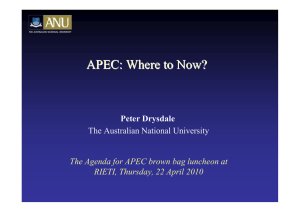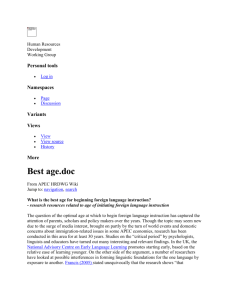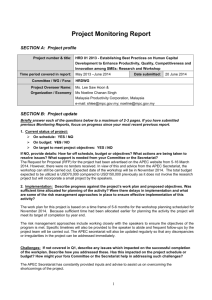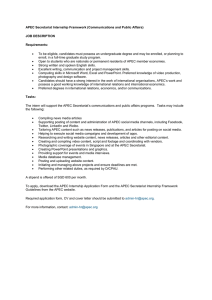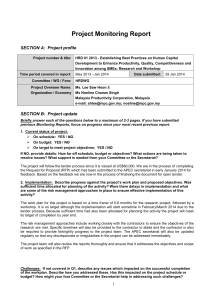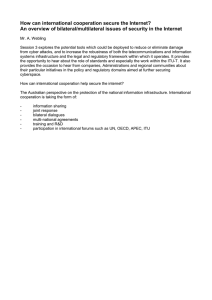roadmap to the asia pacific economic community
advertisement
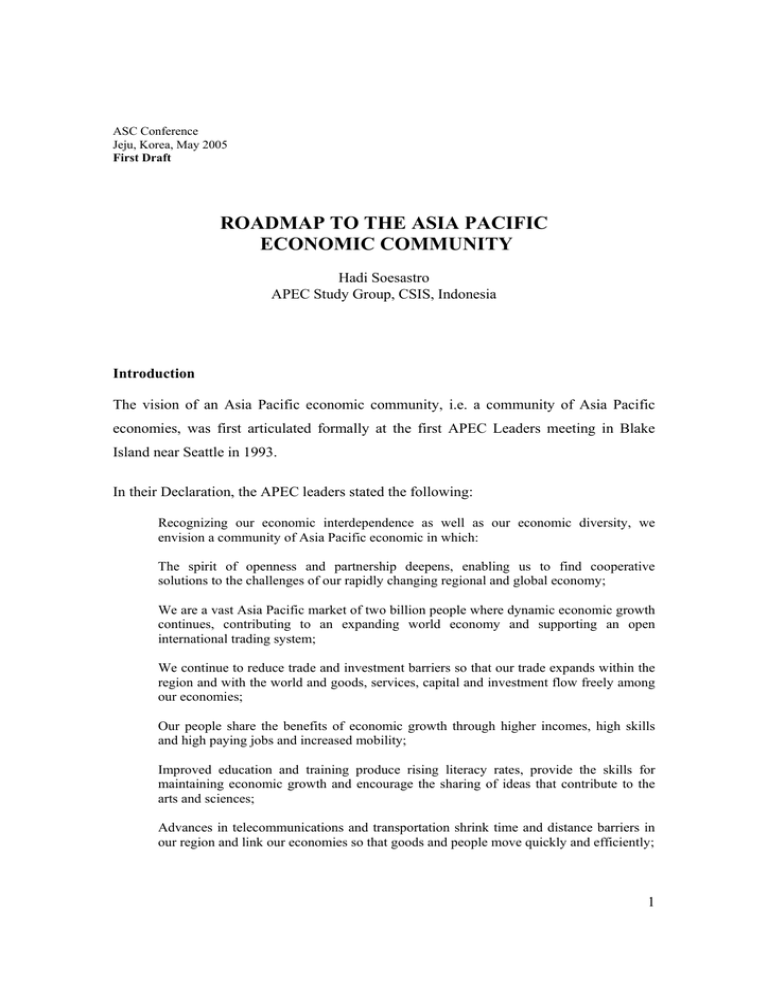
ASC Conference Jeju, Korea, May 2005 First Draft ROADMAP TO THE ASIA PACIFIC ECONOMIC COMMUNITY Hadi Soesastro APEC Study Group, CSIS, Indonesia Introduction The vision of an Asia Pacific economic community, i.e. a community of Asia Pacific economies, was first articulated formally at the first APEC Leaders meeting in Blake Island near Seattle in 1993. In their Declaration, the APEC leaders stated the following: Recognizing our economic interdependence as well as our economic diversity, we envision a community of Asia Pacific economic in which: The spirit of openness and partnership deepens, enabling us to find cooperative solutions to the challenges of our rapidly changing regional and global economy; We are a vast Asia Pacific market of two billion people where dynamic economic growth continues, contributing to an expanding world economy and supporting an open international trading system; We continue to reduce trade and investment barriers so that our trade expands within the region and with the world and goods, services, capital and investment flow freely among our economies; Our people share the benefits of economic growth through higher incomes, high skills and high paying jobs and increased mobility; Improved education and training produce rising literacy rates, provide the skills for maintaining economic growth and encourage the sharing of ideas that contribute to the arts and sciences; Advances in telecommunications and transportation shrink time and distance barriers in our region and link our economies so that goods and people move quickly and efficiently; 1 Our environment is improved as we protect the quality of our air, water and green spaces and manage our energy sources and renewable resources to ensure sustainable growth and provide a more secure future for our people. The APEC approach thus far is not to define a “roadmap” to realizing this vision. This follows from the nature of the APEC process, which is driven by subsequent APEC governments that chair APEC. An APEC government can built on previous initiatives in developing its chairmanship agenda, but it can opt for going into a totally new direction, of course with the endorsement of other APEC members. It is the host government of the annual APEC (leaders and ministers) meetings that largely determines APEC’s footprint. This is particularly so since the institution of the APEC Summit. The agreements and commitments made in subsequent summits can be seen as milestones of an uncharted APEC roadmap. To qualify the above statement, some APEC members can have an overbearing influence on the APEC process even though they are in the chairmanship’s role. This has been the case with the US after September 11. The US has introduced in APEC an agenda of fighting international terrorism that often has overshadowed APEC’s other agenda. Some see this as diversion from APEC’s efforts to realizing its vision, but others consider cooperation in the field of combating international terrorism as an integral part of regional community building. These activities are now encapsulated under APEC’s agenda to enhance human security. A Review of APEC’s Initiatives Following the first meeting at Blake Island (USA), APEC leaders met the next year in Bogor (Indonesia). There they made a bold decision by pledging to achieve “free and open trade and investment in the Asia Pacific region” by 2010 for developed members and 2020 for developing members. This is known as the Bogor Goals. In addition, 2 leaders endorsed the twelve Non-binding Investment Principles (NBIP) to facilitate investment flows within the region. At the following meeting in Osaka (Japan) in 1995, APEC governments decided to translate the Blake Island vision and the Bogor goals into reality by endorsing the Osaka Action Agenda (OAA). The OAA provides a blueprint for implementing the leaders’ commitment to free and open trade and investment, business facilitation, and economic and technical cooperation. The OAA has since defined the two pillars of the APEC process, namely TILF (trade and investment liberalization and facilitation) and ECOTECH (economic and technical cooperation). The TILF agenda is pursued through IAPs (individual action plans), particularly in regard to liberalization measures, and CAPs (collective action plans). The Summit at Subic (Philippines) produced the Manila Action Plan for APEC (MAPA) which provided a framework to integrate IAPs and CAPs that were implemented from 1 January 1997 onwards. The APEC Leaders meeting in 1997 in Vancouver (Canada) focused on ECOTECH issues. It took up the FEEEP (food, environment, energy, economic development and population) program that was proposed in the previous year, but no specific initiatives were introduced. Instead, leaders endorsed the Vancouver Framework for Enhanced Public-Private Cooperation on Infrastructure. Under the TILF agenda, governments agreed to start the ill-fated EVSL (Early Voluntary Sectoral Liberalization) Initiative towards tariff reduction in 15 specific sectors. In addition, leaders also endorsed the Blueprint for Customs Modernization, which was aimed at streamlining customs procedures by 2001. In the following year, at the meeting in Kuala Lumpur (Malaysia), the focus was on cooperation in human resources development, which was an important element of the Blake Island vision. The leaders adopted the Kuala Lumpur Action Program on Skills Development. This program was to contribute towards sustainable growth and equitable development and was of particular interest to the developing members of APEC. No new 3 initiatives were taken in the TILF agenda. Some observers were quick to point out that APEC has been derailed from its original track. Perhaps in response to those concerns, the APEC Leaders meeting in 1999 in Auckland (New Zealand) reaffirmed their commitment to achieve the Bogor goals. They also reaffirmed the importance of promoting open, transparent and well-governed markets, specifically by endorsing the APEC Principles to Enhance Competition Policy and Regulatory Reform. New Zealand was proud to have produced a Framework for the Integration of Women into APEC. In Brunei Darussalam in the following year, a major decision by the leaders was to bridge the Digital Divide by pledging to double the number of people with access to the Internet by 2010. In Shanghai (China) in 2001, the leaders produced the Shanghai Accord to revitalize trade and investment liberalization. However, the meeting was dominated by concerns over global terrorism and APEC’s response to it. When Mexico hosted APEC in Los Cabos in 2002, it proposed to give serious attention to the consolidation of the APEC process as concerns became more widespread that APEC has lost steam. In addition, it proposed to complement APEC’s economic and trade liberalization goals with social and development targets as a way to promote shared prosperity in the region. In particular, it pointed to the need to strengthen SMEs. The meeting in 2003 in Bangkok (Thailand) again reaffirmed the commitment to promote trade and investment liberalization. In addition, the Declaration stipulated measures to enhance human security as well as to using APEC to help people and society benefit from globalization. It appears that at the Bangkok meeting a kind of consensus has emerged that APEC’s “new” agenda will consist of three broad agendas: TILF, enhancing human security, and social development. This was modified in the following meeting in Santiago (Chile) when leaders reaffirmed their commitment to achieve sustainable and equitable growth and reduce economic disparities for the well-being of the people by meeting the Bogor Goals of trade and investment liberalization and facilitation, enhancing human security, and promoting good governance and a knowledge-based society. The leaders 4 adopted the Santiago Initiative for Expanded Trade, which gave particular attention to capacity building, and the Santiago Commitments to Fight Corruption and Ensuring Transparency. The above brief review shows that over the years APEC governments have taken numerous initiatives to promote cooperation and to achieve the APEC vision of an Asia Pacific economic community. They could be seen as milestones of the APEC roadmap. Yet, many of those initiatives appear to have met with a dead end or faced with great obstacles. If an opinion survey were to be conducted in the region it can be speculated that most people would not be able to mention any of the above initiatives that APEC has taken over the year. A few amongst the elite would have heard about the Bogor Goals, but they would not be able to say precisely what they are. And yet, the Bogor Goals are perhaps the most concrete target that has been set for APEC, albeit it is only one of several means to achieving the APEC vision. The Issues As suggested before, the APEC agenda today can be seen as having the following components: TILF and ECOTECH that have been introduced since 1995, and a third component, namely EHS (enhancing human security), which has emerged since 2001. These three components are regarded as important to achieving the APEC vision. However, there does not seem to be a clearly defined roadmap for each of these components. Should there be this roadmap? Is the absence of it that accounts for the lack of clear achievements? Or, is it rather the problem of the vehicle and not the lack of the roadmap? Perhaps, it is both. 5 Let us briefly look at each component of the APEC agenda. APEC’s liberalization agenda is defined by the Bogor Goals and is implemented through the OAA’s IAPs and CAPs. The problem here is lack of specificity of what constitute the Bogor Goals: will all barriers to trade and investment have to be (fully) eliminated by the end date? Can there be exclusions of so-called sensitive sectors, and how will they be determined? What discipline will be applied to the exclusion list? Should they be progressively reduced as in the case of the ASEAN Free Trade Area (AFTA)? APEC governments have continuously postponed addressing these questions. Without having a clear idea of what the Bogor Goals entail, it will be difficult to define the roadmap to achieving them. And yet, there is now widespread feeling that by 2010 APEC developed members will not be able to deliver on the Bogor Goals. Is this because of APEC’s modality of “concerted unilateral liberalization”? Can APEC’s peer review process be strengthened so that APEC members will produce stronger and bolder IAPs? Or should APEC be transformed from being a voluntary process (V-APEC) to becoming more binding (B-APEC)? The APEC Business Advisory Council (ABAC) recently calls on APEC governments to move towards a B-APEC. However, the more feasible option for APEC is to strengthen the mechanisms of a V-APEC (Soesastro, 2005). In the areas of facilitation, APEC has undertaken many activities that are useful to promoting trade and investment. However, there are no mechanisms in APEC to ensure that members will implement agreements, improved practices or policy changes. Without such mechanism, it is unlikely that there can be a roadmap for APEC. APEC’s ECOTECH agenda has suffered from serious problems from the outset. There has been a lack of clear articulation by APEC members about its significance and the development of a meaningful approach to promote it. It has been a collection of disparate initiatives and projects. Suggestions for introducing an overarching framework (e.g., Elek and Soesastro, 2000) have met with limited success as governments continue with the way they design and implement economic and technical cooperation initiatives and programs. 6 And finally, EHS is an equally difficult proposition. Certain quarters in society view APEC itself as a manifestation of the threat to human security, especially for the weak and the marginalized groups in society. APEC governments have clearly identified the critical role of governance in overcoming this problem, but it remains to be seen how they can translate their initiatives in this area into concrete cooperation programs. In addition to examining the issue of APEC’s roadmap, perhaps attention should also be given to fixing the vehicle in which the Asia Pacific region will venture. References Elek, Andrew and Hadi Soesastro (2000), “Ecotech at the heart of APEC: capacitybuilding in the Asia Pacific,” in Ippei Yamazawa (ed.), Asia Pacific Economic Cooperation (APEC) -- Challenges and tasks for the twenty-first century (London: Routledge), pp.218-254. Soesastro, Hadi (2005), “Re-writing APEC’s Approach?” in Mark Borthwick et al, The Future of APEC and Regionalism in Asia Pacific (Jakarta: Centre for Strategic and International Studies, and PECC), pp. 1-8. 7
